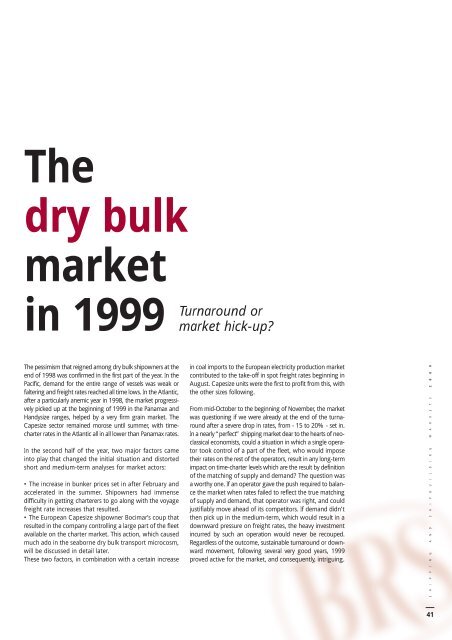You also want an ePaper? Increase the reach of your titles
YUMPU automatically turns print PDFs into web optimized ePapers that Google loves.
The<br />
dry bulk<br />
market<br />
in 1999<br />
The pessimism that reigned among dry bulk shipowners at the<br />
end of 1998 was confirmed in the first part of the year. In the<br />
Pacific, demand for the entire range of vessels was weak or<br />
faltering and freight rates reached all time lows. In the Atlantic,<br />
after a particularly anemic year in 1998, the market progressively<br />
picked up at the beginning of 1999 in the Panamax and<br />
Handysize ranges, helped by a very firm grain market. The<br />
Capesize sec<strong>to</strong>r remained morose until summer, with timecharter<br />
rates in the Atlantic all in all lower than Panamax rates.<br />
In the second half of the year, two major fac<strong>to</strong>rs came<br />
in<strong>to</strong> play that changed the initial situation and dis<strong>to</strong>rted<br />
short and medium-term analyses for market ac<strong>to</strong>rs:<br />
• The increase in bunker prices set in after February and<br />
accelerated in the summer. Shipowners had immense<br />
difficulty in getting charterers <strong>to</strong> go along with the voyage<br />
freight rate increases that resulted.<br />
• The European Capesize shipowner Bocimar’s coup that<br />
resulted in the company controlling a large part of the fleet<br />
available on the charter market. This action, which caused<br />
much ado in the seaborne dry bulk transport microcosm,<br />
will be discussed in detail later.<br />
These two fac<strong>to</strong>rs, in combination with a certain increase<br />
Turnaround or<br />
market hick-up?<br />
in coal imports <strong>to</strong> the European electricity production market<br />
contributed <strong>to</strong> the take-off in spot freight rates beginning in<br />
August. Capesize units were the first <strong>to</strong> profit from this, with<br />
the other sizes following.<br />
From mid-Oc<strong>to</strong>ber <strong>to</strong> the beginning of November, the market<br />
was questioning if we were already at the end of the turnaround<br />
after a severe drop in rates, from - 15 <strong>to</strong> 20% - set in.<br />
In a nearly “perfect” shipping market dear <strong>to</strong> the hearts of neoclassical<br />
economists, could a situation in which a single opera<strong>to</strong>r<br />
<strong>to</strong>ok control of a part of the fleet, who would impose<br />
their rates on the rest of the opera<strong>to</strong>rs, result in any long-term<br />
impact on time-charter levels which are the result by definition<br />
of the matching of supply and demand? The question was<br />
a worthy one. If an opera<strong>to</strong>r gave the push required <strong>to</strong> balance<br />
the market when rates failed <strong>to</strong> reflect the true matching<br />
of supply and demand, that opera<strong>to</strong>r was right, and could<br />
justifiably move ahead of its competi<strong>to</strong>rs. If demand didn’t<br />
then pick up in the medium-term, which would result in a<br />
downward pressure on freight rates, the heavy investment<br />
incurred by such an operation would never be recouped.<br />
Regardless of the outcome, sustainable turnaround or downward<br />
movement, following several very good years, 1999<br />
proved active for the market, and consequently, intriguing.<br />
S H I P P I N G A N D S H I P B U I L D I N G M A R K E T S 2 0 0 0<br />
41


